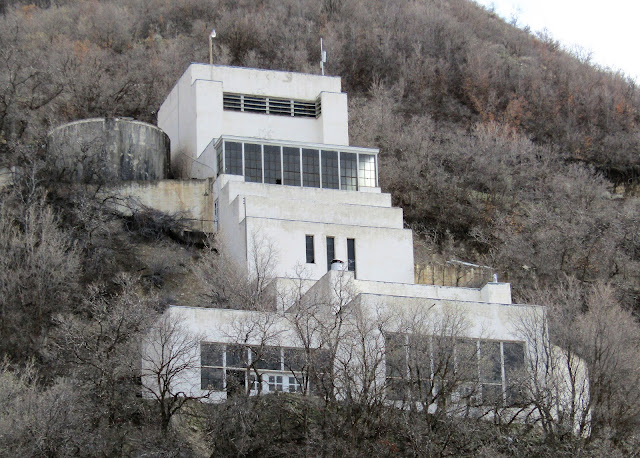by Peter
This is one that fascinated me as a kid growing up in Pleasant Grove. It’s clearly visible on aerial photographs, a long, narrow rectangle mostly clear of the scrub oak that is all over the back side of G Mountain. If you look at it closely, it’s pretty clear it’s a reservoir, but I never knew what it was for until a few years ago.
I was hired to do several archaeological surveys that intersected with historic hydroelectric plants in one way or another, including a survey for Pleasant Grove in Battle Creek Canyon.
 |
| The view down Battle Creek Canyon. Utah Lake is in the distance. |
It turns out that the turn of the 20th Century (1885-1920) saw an incredible boom in small-scale, privately owned hydroelectric power plants. One of the most important companies of this period was Telluride Power. Telluride had been founded in Colorado in 1890 to use new Westinghouse technology to provide electrical power to a local mine. With the success of their first plant (the Ames Plant near Ophir, Colorado), Telluride’s president, Lucien Nunn, looked around the West for promising locations. Utah, with its abundance of steep mountain streams and rich mining areas, was promising.
Lucien and his brother Paul moved to Provo and began constructing plants. Their first plant was located in Provo Canyon (present-day Nunn’s Park, named after Lucien). They and other companies eventually built on almost every stream coming out of the Wasatch Mountains, including Battle Creek in Pleasant Grove.
 |
| Battle Creek |
The Battle Creek plant was a Neoclassical brick building with a temple-front. It nestled back into the front of G Mountain just north of the current Kiwanis Park. The plant was served by collecting water far up Battle Creek Canyon on the slopes of Mount Timpanogos. The water was run through a wood-stave pipe up to the reservoir on the back of G Mountain, then down through a steel pipe (called a penstock) to turn the turbines in the plant. A caretaker lived near the reservoir to control the flow of water and inspect the pipe.
 |
| This is hard to see, but it's one of the stone dams to capture water for the hydroelectric plant. |
 |
| Remains of the wood-stave pipe. |
 |
| A steel elbow, used at the corners on the pipeline route. Wood-stave doesn't bend well. |
 |
| The reservoir. I haven't been back up to look for the caretaker's house, yet. |
Another time I’ll write about the main Telluride Power location, the Olmsted Plant at the mouth of Provo Canyon, and their institute to train electrical engineers.
 |
| The reservoir with Mount Timpanogos in the background. |
If you'd like a guide to see the things I've posted here, let Peter know.









Thanks for posting this. I didn't know anything about this even though I grew up at the foot of G mountain (1970 forward).
ReplyDeleteMy dad, John Gourley, fixed the wood pipe when he was a teenager.
ReplyDelete